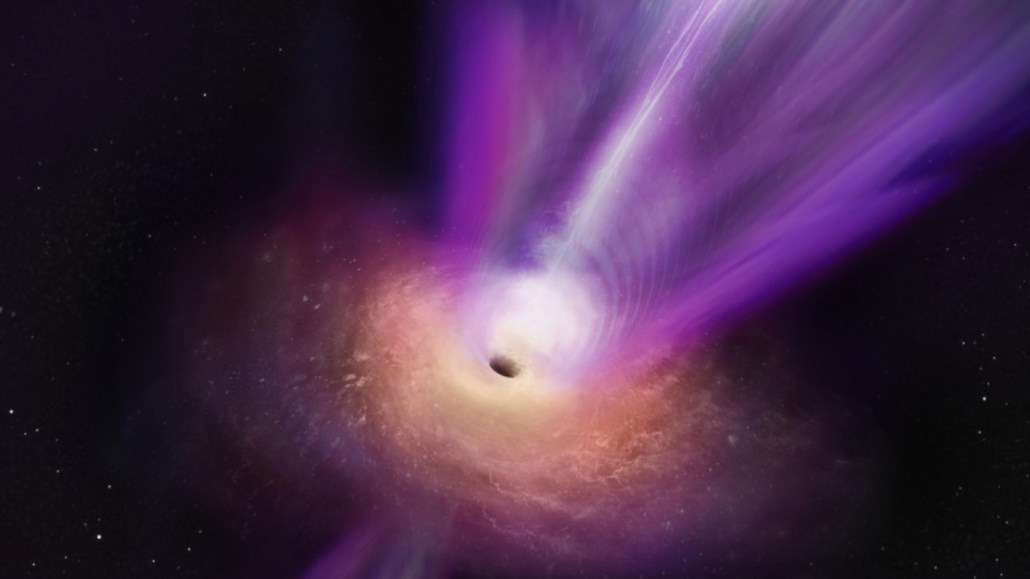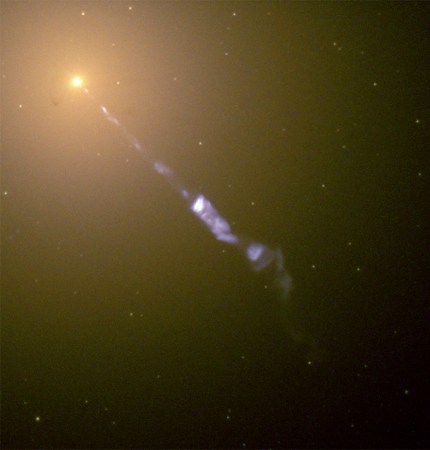
The black hole at the center of galaxy M87 (illustrated) fuels a powerful jet of gas that is triggering the explosions of stars in the galaxy, a study finds.
© Sophia Dagnello, NRAO/AUI/NSF
High-speed gas shooting from the galaxy M87 is causing stars to go nova, a study suggests, and no one knows how.
A nova occurs after a dense star known as a white dwarf receives gas from an orbiting star (SN: 2/12/21). As the white dwarf’s intense gravity squeezes the gas, it heats up and explodes, but both stars survive the violence. In fact, over millions of years, the same star goes nova again and again. Recent observations indicate that these eruptions forged much, and perhaps most, of the universe’s supply of the valuable metal lithium (SN: 5/7/19).
Nova explosions erupt in our galaxy as well as others, including the giant elliptical M87, whose jet of fast-moving gas is powered by the black hole at the galaxy’s center (SN: 4/10/19). Now Hubble Space Telescope data show that there’s an excess of these explosions along M87’s jet, researchers report in a study submitted September 28 to arXiv.org.
Alec Lessing, an undergraduate student at Stanford University, Michael Shara, an astronomer at the American Museum of Natural History in New York City, and their colleagues used the telescope to locate 135 nova outbursts in M87, whose jet is many thousands of light-years long. The galaxy itself is 54 million light-years from Earth, at the heart of the nearest galaxy cluster, named Virgo.

After identifying the nova explosions, the team plotted their positions in the galaxy. “It was striking to the eye,” Shara says of the plot. “The novae appeared to be preferentially aligned with the jet.”
By dividing the galaxy into 10 equal sectors, the astronomers found that 25 blasts occurred along the jet — versus only 10 to 16 in each of the galaxy’s other sectors. The chance that this is just a statistical fluke is only about 0.3 percent, the researchers say.
“I was really surprised,” says Massimo Della Valle, an astronomer at the Italian National Institute for Astrophysics in Naples, who was not involved with the new study. “If these objects are novae, the jet has to be responsible for this somehow.”
Perhaps, he says, the jet pushes interstellar gas onto white dwarf stars in nova systems, increasing the amount of material that accumulates on the stars’ surfaces. As a result, the white dwarfs explode more frequently than they otherwise would, accounting for the surplus of nova outbursts along the jet.
The jet itself, Shara says, doesn’t seem to supply enough gas or radiation to explain the explosions. “The jet is to blame, but we just don’t know why or how,” he says. “It is somehow causing the novae to be more prevalent in that sector, but whether it’s because it’s triggering the novae somehow or birthing the novae — making more of them there — or some other process … we don’t know.”
For additional clues, Shara hopes to use Hubble to examine other galaxies that resemble M87, to see whether their jets are also accompanied by such eruptions.







